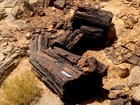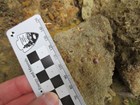All across the park system, scientists, rangers, and interpreters are engaged in the important work of studying, protecting, and sharing our rich fossil heritage. Park Paleontology News provides a close up look at the important work of caring for these irreplaceable resources.
- Contribute to Park Paleontology News by contacting the newsletter editor
- Learn more about Fossils & Paleontology
- Celebrate National Fossil Day with events across the nation
-
Saint Croix National Scenic Riverway
Article 1: Paleontology of St. Croix National Scenic Riverway
St. Croix National Scenic Riverway contains some of the most notable Cambrian fossil localities in the National Park System. Geological explorations beginning in the 1840s have revealed a fauna of brachiopods, snails and snail-like mollusks, trilobites, graptolites, burrowing animals, and others. These organisms populated the region between approximately 500 and 490 million years ago, when it was a shallow tropical sea. Read more
-
Lake Mead National Recreation Area
Article 2: Paleontology at Lake Mead National Recreation Area

Lake Mead NRA is located a few miles east of Las Vegas, and serves as a welcome respite in the blazing heat of the Mojave desert summers. At the forefront of Lake Mead NRA’s conservational efforts are resource protection and education to visitors about the park’s desert wildlife, native fish and invasive species, and cultural history - far lesser known has been the park’s long and important paleontological story. Read more
-
National Capital Parks-East
Article 3: The Paleontological Resources of National Capital Parks East

National Capital Parks-East (NACE) was established in 1965. NACE consists of about includes about 15 parks and sites between Washington DC and parts of Maryland. The parks range from natural resource parks, to historical sites, to recreational areas. About half of the parks at NACE are known to have fossil resources and fossils in the museum collection. Read more
-
Hagerman Fossil Beds National Monument
Article 4: New Discoveries from Old Bones at Hagerman Fossil Beds National Monument

Hagerman Fossil Beds National Monument is a relatively small and unassuming fossil site located along the sinuous Snake River in southern Idaho. Its fossils date from the early half of the Pliocene and range in age from approximately 4.2 to 3 million years in age. The Monument is best known for its fossil horses. However, nearly two hundred species of animals have been recorded at Hagerman such as water and wetland birds, rodents, larger mammals, and many carnivorans. Read more
-
Glen Canyon National Recreation Area
Article 5: Young Paleontologist Helps to Uncover the Fossil Record at Glen Canyon National Recreation Area
If you’re looking for one of the most complete sections of geologic strata of the Mesozoic Era, then you must visit Glen Canyon National Recreation Area. My name is Maria Rodriguez and I am a physical science technician in GLCA. With its 1.2 million acres, Glen Canyon NRA houses a rare and valuable geological history. My work focuses mainly on vertebrate ichnology, or “fossil footprints”. Read more


